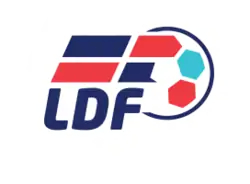Liga Dominicana de Fútbol
The Liga Dominicana de Fútbol is the first professional football league in Dominican Republic, it was launched in March 2015.[1] For sponsorship reasons it is known as LDF Banco Popular.[2]
 | |
| Founded | 2014 |
|---|---|
| Country | Dominican Republic |
| Confederation | CONCACAF |
| Number of teams | 12 |
| Level on pyramid | 1 |
| Domestic cup(s) | Copa Dominicana de Fútbol |
| International cup(s) | CFU Club Championship |
| Current champions | Atlético Pantoja (2nd title) |
| Most championships | Atlético Pantoja (2 titles) |
| Website | Liga Dominicana de Fútbol |
| Current: 2019 Liga Dominicana de Fútbol | |
Competition format
In the first three installments, each team played 18 matches in the regular season, the 4 teams with most points qualify for the playoffs. The champion will be decided in a single-legged final.
The 2018 season will have grown from 10 to 12 teams with the arrival in San Francisco de Macoris (Atlético) and Bayaguana (Inter). Delfines of the East at the end will be able to play in La Romana so the LDF will have a presence in seven provinces and the National District, and the only professional league with a team in the South region San Cristóbal.
The tournament will feature 132 regular series matches. Each team will play 22 games in the regular phase (instead of the 18 of the first three editions), the six highest scoring will advance to the second phase, where they will play one against all in a round. The best four will advance to a semi-final with round-trip matches and the winners will play the championship in a single match, which extends the league calendar to 152 matches from 95 in 2017.
As a novelty, the LDF 2018 season will have a national and international television transmission chain that will bring to the small screen 60 matches at the local level and a number of meetings to be defined that will be taken to at least five nations of the region, including the United States and Mexico
The 2019 tournament of the Liga Dominicana de Futbol will start with 12 teams. The event will be developed with a new format, each of the twelve clubs can have up to 6 foreign players on their payroll.
The new format includes an "Apertura" and a "Clausura" tournament, both will be played one round and has been agreed with the twelve clubs and also with CONCACAF. The "Apertura" will have a semifinal with the four best teams and then a final, as well as the "Clausura".
Then the champion of each tournament will compete to win the qualification to the CONCACAF championship tournament. Another club will qualify for the CONCACAF tournament, accumulating the most points in both tournaments.
Teams
Former teams
| Team | City | Stadium (capacity) | First season |
Last season |
Head coach | Record W/T/L |
|---|---|---|---|---|---|---|
| Bauger FC | Santo Domingo | Estadio Olímpico Félix Sánchez (27,000) | 2015 | 2017 | Jorge Rolando Baguer | 24/06/24 |
Champions
| Year | Playoff Champions (Champions) |
Regular Season (Regular Season) |
Runner-up | Top Scorer(s) | Top Scorer's Club | Goals |
|---|---|---|---|---|---|---|
| 2015 | Pantoja | Bauger | Atlántico FC | Jonathan Faña | Bauger | 17 |
| 2016 | Barcelona Atlético | Barcelona Atlético | Cibao | Anderson Arias | Club Barcelona Atlético | 11 |
| 2017 | Atlántico FC | Cibao FC | Club Atlético Pantoja | Armando Maita, Mauro Gomez, Woodensky Cherenfant | Club Atlético Pantoja, Atlántico FC, Cibao FC | 10 |
| 2018 | Cibao FC | Atlético de San Francisco | Atlético de San Francisco | Fredys Arrieta | Atlético de San Francisco | 18 |
| 2019 | Club Atlético Pantoja | Cibao FC | Cibao FC | Pablo Marisi | Club Atlético Pantoja | 13 |
2019 Liga Dominicana de Fútbol
Most goals
| Place | Player | Country | Team (s) | Goals |
|---|---|---|---|---|
| 1 | Jonathan Faña | Bauger FC (2015) Cibao FC (2016) Moca FC (2017-) | 30 | |
| 2 | Berthame Dine | Atlántico FC (2015) Atlético Vega Real (2016-) | 24 | |
| 3 | Anderson Arias | Atlántico FC (2015) Club Barcelona Atlético (2016) O&M FC (2017-) | 23 | |
| 4 | Bony Pierre | Bauger FC (2015-2016) Club Barcelona Atlético (2017-) | 21 | |
| 5 | Domingo Peralta | Cibao FC (2015-) | 18 |
Stadiums and locations
Current LDF stadiums
| Atlántico FC | Atlético San Cristóbal | Atlético Vega Real | Jarabacoa FC | |
|---|---|---|---|---|
| Estadio Leonel Plácido | Estadio Panamericano | Estadio Olímpico (La Vega) | Estadio Olímpico (La Vega) | |
| Capacity: 2,000 | Capacity: 3,000 | Capacity: 7,000 | Capacity: 7,000 | |
| Club Atlético Pantoja | Club Barcelona Atlético | Delfines Del Este | Moca FC | |
| Estadio Olímpico Félix Sánchez | Estadio Olímpico Félix Sánchez | Estadio Municipal La Romana | Estadio Complejo Deportivo Moca 86 | |
| Capacity: 27,000 | Capacity: 27,000 | Capacity: 1,200 | Capacity: 2,000 | |
| Cibao FC | Universidad O&M FC | Inter RD | Atlético San Francisco | |
| Estadio Cibao FC | Estadio Olímpico Félix Sánchez | Complejo deportivo de Bayaguana | Olímpico de San Francisco de Macoris | |
| Capacity: 10,000 | Capacity: 27,000 | Capacity: 1,800 | Capacity: 500 | |
References
- "Dominican Republic launches professional league". CONCACAF. 10 March 2015. Archived from the original on 30 March 2015. Retrieved 25 March 2015.
- "Banco Popular y la Federación Dominicana de Fútbol firman alianza estratégica" (in Spanish). El Nuevo Diario. 23 March 2015. Retrieved 25 March 2015.
